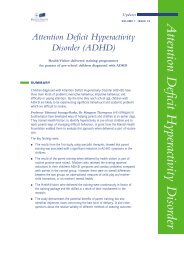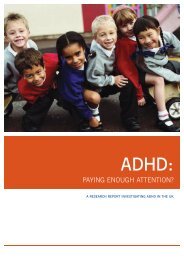Low self-esteem and psychiatric patients - BioMed Central
Low self-esteem and psychiatric patients - BioMed Central
Low self-esteem and psychiatric patients - BioMed Central
Create successful ePaper yourself
Turn your PDF publications into a flip-book with our unique Google optimized e-Paper software.
Annals of General Hospital Psychiatry 2003, 2http://www.general-hospital-psychiatry.com/content/2/1/2simply representative of poor psychological health regardlessof the diagnosis.One of the major problems in the area of <strong>self</strong>-<strong>esteem</strong> researchis the lack of a clear consensus definition. Self-<strong>esteem</strong>has been given a number of different definitions,each emphasising different aspects [4]. Hence, measurementinstruments based on different definitions sometimeshave poor correlation. An appropriate approach tobetter evaluate <strong>self</strong>-<strong>esteem</strong> may therefore be to use morethan one measure of <strong>self</strong>-<strong>esteem</strong>.<strong>Low</strong>ered <strong>self</strong>-<strong>esteem</strong> has been consistently found to occurin several <strong>psychiatric</strong> disorders. These include major depressivedisorder, eating disorders, anxiety disorders, <strong>and</strong>alcohol <strong>and</strong> drug abuse. For example, there are multiplestudies demonstrating that <strong>patients</strong> with major depressivedisorder have lowered <strong>self</strong>-<strong>esteem</strong> [2,8,9]. <strong>Low</strong>ered <strong>self</strong><strong>esteem</strong>has also been considered a psychological hallmarkof most <strong>patients</strong> with eating disorders [10–12]. Indeed,lowered <strong>self</strong>-<strong>esteem</strong> has been suggested to be the finalcommon pathway leading to eating disorders [13,14].Studies have shown that with increasing anxiety <strong>self</strong>-<strong>esteem</strong>decreases [15,16,5]. However, in a study comparingthe <strong>self</strong>-<strong>esteem</strong> of <strong>patients</strong> with different <strong>psychiatric</strong> diagnoses,<strong>patients</strong> with anxiety disorders had the highest <strong>self</strong><strong>esteem</strong>[17]. The relationship between alcohol dependence<strong>and</strong> lowered <strong>self</strong>-<strong>esteem</strong> has also long been recognised[1,18,19]. A relationship between the use of drugs<strong>and</strong> low <strong>self</strong>-<strong>esteem</strong> has been demonstrated in a numberof studies [20–23].Despite these studies, it remains unclear whether lowered<strong>self</strong>-<strong>esteem</strong> occurs in a few discrete <strong>psychiatric</strong> conditions,or in all <strong>psychiatric</strong> conditions, <strong>and</strong> also whether <strong>self</strong>-<strong>esteem</strong>is equally lowered in different <strong>psychiatric</strong> conditions.The aim of the present study is to address theseissues.MethodsPopulation SampleThe current study was carried out on data collected on aconsecutive sample of 1,190 cases attending the Walk-Inclinic at the University of Alberta Hospital, Edmonton,Canada. The sample consisted of 957 <strong>psychiatric</strong> <strong>patients</strong>,182 cases with conditions not attributable to a mental disorderbut due to psychosocial stressors ("V-codes" inDSM-III R), <strong>and</strong> 51 controls who accompanied <strong>patients</strong><strong>and</strong> were themselves assessed but did not receive a <strong>psychiatric</strong>diagnosis (controls). The Walk-In clinic refers to a<strong>psychiatric</strong> open access clinic where <strong>patients</strong> can referthemselves or be referred through a family doctor. A therapist,who is a psychologist, a social worker or a <strong>psychiatric</strong>nurse, sees each patient. Any diagnoses made are thenconfirmed during a subsequent interview with a psychiatrist,with a final consensus diagnosis being made accordingto DSM III-R criteria. It is common practice in theWalk-In clinic that frequently the individuals who accompanythe patient, particularly the family members, willalso be assessed. As part of the assessment, all subjectscomplete a questionnaire containing two <strong>self</strong>-<strong>esteem</strong>scales.Self-Esteem ScalesTwo well-recognized patient-completed questionnaireswere used to measure <strong>self</strong>-<strong>esteem</strong>. These were the Janis<strong>and</strong> Field Social Adequacy Scale (JF Scale) [24] <strong>and</strong> theRosenberg Self-Esteem Scale (Rosenberg Scale) [25]. TheJF Scale is available in Appendix 1 (see additional file 1)<strong>and</strong> the Rosenberg Self-Esteem Scale is available in Appendix2 (see additional file 2). The JF Scale consists of 23<strong>self</strong>-rating items, which measure anxiety in social situations,<strong>self</strong>-consciousness, <strong>and</strong> feelings of personal worthlessness.The maximum score is 115, <strong>and</strong> a higher scorereflects increased <strong>self</strong>-<strong>esteem</strong>. Reliability estimates basedon the Spearman-Brown formula <strong>and</strong> split-half reliabilityestimates for this scale are 0.91 <strong>and</strong> 0.83, respectively.The Rosenberg Scale measures global <strong>self</strong>-<strong>esteem</strong> <strong>and</strong> personalworthlessness. It includes 10 general statements assessingthe degree to which respondents are satisfied withtheir lives <strong>and</strong> feel good about themselves. In contrast tothe JF Scale, a lower score reflects higher <strong>self</strong>-<strong>esteem</strong>. Inthe original report, Rosenberg quoted a reproducibility of0.9 <strong>and</strong> a scalability of 0.7. The Rosenberg Scale has previouslybeen validated in other studies [25–27]. It is themost widely used scale to measure global <strong>self</strong>-<strong>esteem</strong> inresearch studies.Grouping of <strong>patients</strong>Individuals were categorized as being in one of the 19groups, including two groups of controls (the "psychosocialstressor" group <strong>and</strong> the healthy "control" group).Eleven of these groups, namely psychotic disorders; majordepression; dysthymia; bipolar disorder; anxiety disorders;alcohol use disorders; drug use disorders; eating disorders;adjustment disorder; conduct disorder; <strong>and</strong>impulse control disorder were according to the DSM-III-Rclassification with two modifications: the group named"psychotic disorders" consisted of schizophrenia, <strong>and</strong>psychotic disorders not elsewhere classified; the psychoactivesubstance use disorders was divided into two groups,namely "alcohol use disorders" (consisting of alcoholabuse <strong>and</strong> alcohol dependence) <strong>and</strong> "drug use disorders"(consisting of drug abuse <strong>and</strong> drug dependence). Fivegroups consisted of <strong>patients</strong> who had comorbid diagnoses.These groups were major depression <strong>and</strong> anxietydisorders; major depression <strong>and</strong> dysthymia; major depression<strong>and</strong> alcohol use disorders; major depression <strong>and</strong>drug use disorders; <strong>and</strong> alcohol <strong>and</strong> drug use disorders.Page 2 of 9(page number not for citation purposes)




